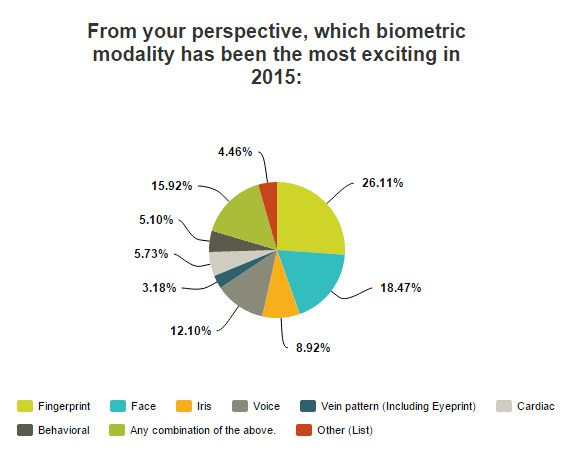 Another year has come and passed, and in terms of biometrics and identity management, the year we’ve left behind was huge. Among the commotion that was 2015 in biometrics, one of the most encouraging and interesting aspects was the range of deployed modalities. Diversity has always been a key component to the biometrics landscape, but last year we saw exactly how important a role it played.
Another year has come and passed, and in terms of biometrics and identity management, the year we’ve left behind was huge. Among the commotion that was 2015 in biometrics, one of the most encouraging and interesting aspects was the range of deployed modalities. Diversity has always been a key component to the biometrics landscape, but last year we saw exactly how important a role it played.
In 2015 there was a shift from previous years—when it looked as if various modalities were competing for the title of ‘one solution to authenticate them all,’—toward a much more accommodating paradigm. One of our most popular webinars of the year, Voice Biometrics in a Multimodal Future, hammered this idea home: certain types of biometric authentication are better suited to certain niches in the bigger biometric picture.
As part of our 13th annual Biometrics Year in Review we asked over 150 survey respondents hailing from identity related industries what modalities they found to be most exciting in 2015. Here’s what they said:
Fingerprint
Fingerprint takes the top spot here and that’s to be expected. Fingerprint biometrics exploded in popularity last year, particularly in the mobile device markets, with an incredible amount of adoption on behalf of OEMs. The modality was made even more exciting for stakeholders in the modality, specifically those who owned stock in Fingerprint Cards (FPC), which was confirmed recently to have been the best performing stock in Europe for the year.
Every major smartphone brand integrated fingerprints into their flagship phones. This move seemed primarily motivated by the highly competitive mobile wallet space that has picked fingerprint sensors as a necessary authenticator to perform in-store payments via NFC enabled handsets.
Outside the consumer sector, fingerprints were still prominent in the verticals too, particularly in law enforcement, border control and physical access. Recent reports that have been released this new year are predicting the modality will continue to hold its prominent position, so fans of the fingerprint can count on keeping up the enthusiasm.
Face
 Facial recognition came in second place on our poll, and in terms of news headlines, the modality was making waves all year. The modality was the subject of a great deal of controversy, finding itself at the forefront of conversations of privacy and biometrics. There were lawsuits filed against companies who had integrated the tech into their platforms and used it on unconsenting users, while disagreements between civil rights organizations and private interests on the topic highlighted the demand for transparency on behalf of parties deploying facial recognition.
Facial recognition came in second place on our poll, and in terms of news headlines, the modality was making waves all year. The modality was the subject of a great deal of controversy, finding itself at the forefront of conversations of privacy and biometrics. There were lawsuits filed against companies who had integrated the tech into their platforms and used it on unconsenting users, while disagreements between civil rights organizations and private interests on the topic highlighted the demand for transparency on behalf of parties deploying facial recognition.
Beyond the controversy, though, we saw a great deal of adoption and innovation. Consumers were given the option to authenticate with their face on Windows devices thanks to the Windows Hello security platform, and it played an increased role in mobile authentication for financial services. As a security solution, facial recognition was the subject of a big biometric win in the historically slippery area of school deployments: St. Mary’s high school in St. Louis implemented a facial recognition physical access system for safety reasons.
Multimodal
 In a close third place we have the multimodal option. 2015 was a big year for combining biometric modalities, either to offer stronger levels of authentication or increased flexibility to the user. Voice and face became very closely associated this year, often bolstering one another in mobile software applications like the USAA banking app (which also offers fingerprint authentication). ZTE launched a series of phones that offered customers their choice between fingerprint and eyeprint verification, and the vertical markets were filled with robust multimodal solutions.
In a close third place we have the multimodal option. 2015 was a big year for combining biometric modalities, either to offer stronger levels of authentication or increased flexibility to the user. Voice and face became very closely associated this year, often bolstering one another in mobile software applications like the USAA banking app (which also offers fingerprint authentication). ZTE launched a series of phones that offered customers their choice between fingerprint and eyeprint verification, and the vertical markets were filled with robust multimodal solutions.
Voice, Iris, et al
 The rest of the data is spread out among the other major modalities as well as the submit-your-own style “other” category which included a few entries for retina scanning. The wide spread of interest among these remaining modalities goes to show how diverse the 2015 identity news was in terms of modality, especially considering the popularity of the third place multimodal category on this survey. Behavioral biometrics were in the anti-fraud sector as well as the physical access market, 2015 saw the world’s first wearable cardiac authenticated payment, and the world’s first iris scanning smartphones were released. Voice, meanwhile, found a particularly useful niche in the Internet of Things, including wearables and connected cars.
The rest of the data is spread out among the other major modalities as well as the submit-your-own style “other” category which included a few entries for retina scanning. The wide spread of interest among these remaining modalities goes to show how diverse the 2015 identity news was in terms of modality, especially considering the popularity of the third place multimodal category on this survey. Behavioral biometrics were in the anti-fraud sector as well as the physical access market, 2015 saw the world’s first wearable cardiac authenticated payment, and the world’s first iris scanning smartphones were released. Voice, meanwhile, found a particularly useful niche in the Internet of Things, including wearables and connected cars.
Iris biometrics pulled its weight in managing the global refugee crisis last year, vital biometrics made strides in enabling remote healthcare, and vein pattern recognition saw its fair share of deployments in financial and mobile environments. Looking back on the year as a whole, 2015 really looks like a time of gains for all types of biometric authentication. As we move forward in 2016 it will be interesting to see what the next steps are and if this paradigm of multiple modalities for multiple situations continues to hold up.
*
Stick with FindBiometrics throughout January as we bring you more results from our 13th annual Year in Review. Be a part of the conversation by following us on Twitter and tweeting with the hashtag #FB2015.
—
January 13, 2016 – by Peter B. Counter




Follow Us